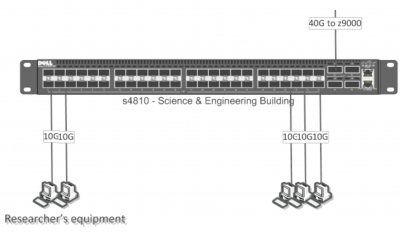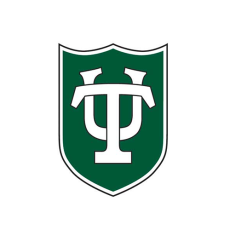Tulane University Cyberinfrastructure Plan - 2014
1. Coherent campus-wide strategy and approach to CI
Tulane University's Technology Services will provide appropriate IT infrastructure and services to different researchers based on their needs by supporting transformative uses of technology for teaching, learning and research, and to enable communication and productivity goals and enhance university business processes for all members of the Tulane community.
Strategic Goals:
- a) Achieve service excellence via continuous improvements and benchmarking
- b) Build virtual and physical communities to support enhanced science via communication, collaboration, and cohesion
- c) Deliver integrated, user-centered processes
- d) Enhance learning in and out of the classroom
- e) Enhance the research enterprise
- f) Support faculty and staff use of technology for work productivity and communication
2. Horizontally integrated with intra-campus resources
a) Tulane has implemented significant upgrades to the network infrastructure throughout its uptown and downtown campuses. Beginning in October of 2011, Tulane Technology Services began deploying $6.6 million of network equipment and new fiber optic and copper cabling. The new infrastructure will immediately provide access to the most technologically current computational resources to dozens of investigators at Tulane who maintain collaborations regionally, nationally and internationally. The speed, reliability, and data management abilities created from these improvements will enable large scale scientific simulations and yield not only faster results and accelerated scientific discovery, but also more comprehensive multidisciplinary work involving graduate students working on dissertations.
b) The campus backbone network infrastructure consists of four fully meshed Juniper ex8200 routers with 10 Gbps connections between each one. Each core router is capable of supporting multiple 10 Gbps streams. Dell Powerconnect 8024 switches were used at the distribution layer in buildings and have been directly connected to the backbone at 10 Gbps via diverse fiber paths for redundancy and multipath utilization. Dell Powerconnect 7048 switches were used for the edge connections to provide 1 Gbps to the desktop. Redundant Juniper srx5800 firewalls and mx960 border routers provide security and to multiple commodity and Internet2 connections for research purposes. The result was that every building on campus is directly connected to two core network routers with 10G connections. The 802.11n wireless standard is used on the wireless network, which consists of Juniper WLA access points and WLC controllers. Also, 1G power-over- Ethernet access ports are on all edge switches. Regular throughput tests are conducted using the perfSONAR toolkit via the Network Diagnostic Tester and Network Path and Application Diagnosis services. These devices allow for the high speed transfer of data between Tulane researchers and resources within the dedicated high-speed science network.
c) Tulane’s Network Services is responsible for the operation and maintenance of the campus data and video networks, which includes the underground fiber and video cable plant, the fiber and wiring plant for the data and video network in each building, and routers, switches, and various other network components. Network Services is also responsible for the design and implementation of data and video networks in new construction as well as renovations to existing facilities. The design and implementation of the dedicated high-speed science network will fall under the purview of Network Services.
d) The network infrastructure at the edge of the dedicated high-speed science network will consist of nine (9) next-generation Force10 s4810 routers designed to meet the requirements for high performance 10/40Gbps connections. Each edge router will provide high density 10/40Gbps aggregation with support up to 2.56 Tbps switch fabric capacity and 1.9Bpps forwarding capacity. Each edge router will be uplinked with a 40Gbps connection to a Force10 z9000 which will be used as the backbone/aggregation point. The backbone router is capable of thirty two 40Gbps connections with a total of 128Tbps of switch fabric capacity and 960Mpps forwarding capacity. All routers in the dedicated high-speed science network are capable of supporting line rate, non-blocking performance throughput with a low latency, friction free implementation, to support high performance computing environments. Research systems within the dedicated high-speed science network will be directly attached to the Force 10 equipment via fiber optic cables with 10gbps connections. The Tulane campus and dedicated high-speed science network networks will be physically and logically separate. All network traffic flowing between the two networks must traverse one of the existing Tulane campus autonomous system routers.

e) The Tulane Technology Support and Network Operations Center will monitor both the Tulane campus and the dedicated high-speed science networks with commercial SNMP/ICMP tools. TechOps personnel will continually measure and monitor network services to ensure high availability and performance. They will also be responsible for the identification and troubleshooting of recurring issues, the escalation of issues to mid and senior level engineering teams for full resolution, and the creation of documentation and process regarding recurring issues, new standard operating procedures, and knowledge transfer material.
3. Vertically integrated with regional and national CI investment and best practices
a) Charlie McMahon has been Tulane University's Vice President for Information Technology and Chief Technology Officer since February 1, 2009. Charlie is a wellknown and respected figure throughout the information technology community because of his prior role as executive director of LONI, and current role as Chair of the LONI Management Council. Charlie was largely responsible for securing the $40 million in funding needed to build and operate LONI, which enables Louisiana researchers to exchange large amounts of data with fellow researchers throughout the country. Dr. Laura Levy is the Associate Senior Vice-President for Research at Tulane University and she sits in the LONI management counsel. She is known for efforts to enhance the peer reviewed, competitive research portfolio at Tulane and ensuring government regulation compliance.
b) As a LONI and Internet2 member institution, Tulane University has made significant investments to supporting the key infrastructure which enables its faculty to maintain collaboration with other major research universities. These investments include increased power capacity and redundancy, fiber optic cabling to connect to LONI resources, and additional cooling in the data center enabling the purposed dedicated high-speed science network to connect to LONI using 2x10Gbps links; thus accommodate dataflow scenarios between the dedicated high-speed science network and other universities and national laboratories which enhances Tulane educational, research, and community missions. Tulane University is also a member of the Eduroam confederation through Internet2.
4. IPv6 Deployment
Tulane has been allocated a provider independent /40 IPv6 network block from ARIN. All network extending equipment including switches, routers, and firewalls are IPv4/IPv6 dual stack capable. IPv6 is implemented on all networks using native dual stack which enables and supports the gradual migration of applications and network services. The deployment model consists of a geographical scheme in which the different campuses and remote locations may participate with service provider peering sessions. Local router and subnet information can easily be identified while also providing an association to IPv4 addressing for documentation purposes. Best practice mechanisms have been implemented on the network to enhance security and provide fault tolerance. The initial deployment relies on stateless address autoconfig, and will be implemented with support for DHCPv6 available as related protocols and operating systems mature. IPv6 commodity and Internet2 peering has been established which allows researchers to utilize new services as they become available. Tulane University also participated in the World IPv6 Launch and is listed via the World IPv6 website as a network operator. Network operators are required to enable IPv6 for enough users so that at least 1% of their subscriber traffic utilizes IPv6.
5. InCommon Federation
The InCommon Federation is the U.S. education and research identity federation, providing a common framework for trusted shared management of access to on-line resources. Through InCommon, Identity Providers can give their users single sign-on convenience and privacy protection, while online Service Providers control access to their protected resources. Tulane University participates in the InCommon federation which allows any federation participating organization to use Shibboleth identity attribute sharing technologies to manage access to online resources which can be made available to the InCommon community.





